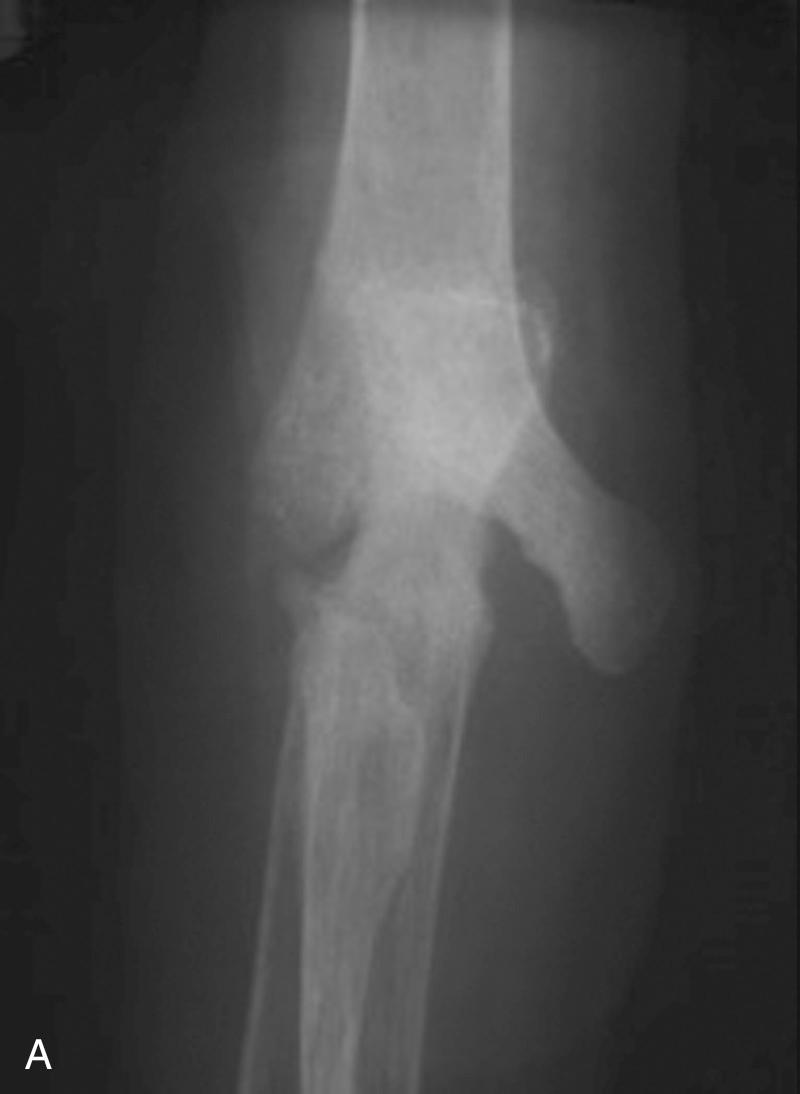Physical Address
304 North Cardinal St.
Dorchester Center, MA 02124
Elbow resection arthroplasty involves removal of the articulating ends of the distal part of the humerus, the proximal part of the ulna, and occasionally the radial head, and letting the soft tissue structures heal around the resected bone segments, hoping for enough stability to allow some function.
With the advent of modern reconstructive procedures, resection arthroplasty of the elbow joint is seldom considered a primary surgical intervention. However, it may still be indicated for patients with severe inflammatory conditions not amenable to other reconstructive procedures, as well as for septic osteomyelitis, at least as the first stage of a two-stage replacement arthroplasty. Currently, the most common indication for elbow resection arthroplasty is the salvage of the infected replacement arthroplasty not amenable to joint reimplantation.
Box 119.1 summarizes current indications for elbow resection arthroplasty. Permanent resection arthroplasty of the elbow is most commonly considered as a salvage procedure for patients who develop a deep infection after elbow arthroplasty. Although a one- or two-stage reimplantation is the treatment strategy of choice for most patients with an infected elbow arthroplasty, permanent resection may be considered for patients with persistent infection after multiple failed reimplantation attempts, especially in the presence of microorganisms resistant to multiple antibiotics, severe bone loss, poor health, and/or a severally compromised soft tissue envelope. Unfortunately, salvage of the infected elbow arthroplasty with arthrodesis has been reported to carry a high failure rate.
Salvage of the infected elbow arthroplasty
Severe congenital deformity or inflammatory joint destruction if
there are extremely narrow medullary canals
there is skin tenting/perforation
Elbow osteomyelitis
Open fractures with severe bone/soft tissue loss (temporary)
Rarely, resection arthroplasty may also be considered for patients with developmental conditions or juvenile rheumatoid arthritis, when there is gross instability and the resorbed distal humerus or proximal ulna tents or perforates the skin but the size of the canals is extremely small and will not accept prosthetic stems. Resection may be performed as a first stage for patients with osteomyelitis or open fractures with severe bone loss and catastrophic soft tissue damage. Some authors have reported resection arthroplasty for patients with inflammatory conditions leading to severe stiffness or ankylosis, but we prefer replacement or interposition arthroplasty in these circumstances.
The goals of resection arthroplasty as a definitive salvage surgical procedure include (1) removal of all infected or devitalized bone and soft tissue, as well as removal of all foreign material (prosthesis, cement, internal fixation devices, contaminating material in open fractures), (2) preservation of as much bone stock as possible, (3) protection of neurovascular structures, and (4) careful soft tissue closure, including the selective use of soft tissue coverage procedures if needed. Preservation of the medial and lateral columns of the distal part of the humerus is perceived to be of paramount importance ( Fig. 119.1 ): the ulna may be stabilized in the fork-like distal part of the humerus, facilitating a more stable resection arthroplasty. Some authors have even reported reconstruction of the condyles with iliac crest bone graft to achieve a stable resection.

Since the infected elbow arthroplasty not amenable to reimplantation is the most common indication for a permanent resection arthroplasty nowadays, we will discuss in some detail the surgical technique for resection of an infected elbow arthroplasty.
Our preference is to place the patient supine, although some surgeons prefer the lateral decubitus position. Use of a sterile tourniquet is recommended as (1) tourniquet use facilitates identification and isolation of the ulnar and radial nerves, (2) a sterile tourniquet may easily be removed if proximal extension of the exposure is needed, and (3) there is less risk of accidental contamination at the proximal aspect of the sterile field.
The previous incision is used whenever possible, especially when the elbow has been previously exposed through a posterior midline skin incision. The wound edges are resected only when devitalized, since excessive skin débridement can compromise wound closure. Careful skin flap elevation is important to (1) keep the subcutaneous flaps as thick as possible and (2) avoid inadvertent iatrogenic injury to the ulnar nerve, which may be located in the most unpredictable locations. The extent of skin flaps is kept to the minimum required for adequate exposure of the elbow joint.
Become a Clinical Tree membership for Full access and enjoy Unlimited articles
If you are a member. Log in here